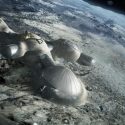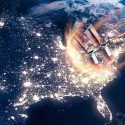Today we’re dropping a big bomb into the deepest part of the ocean. So grab a surfboard and get ready to hang ten on the waves of a massive nuclear tsunami. How would you deliver a nuke to the bottom of the Mariana Trench? What would this underwater explosion be like? And what kind of destruction would it cause?
Welcome to the deepest, darkest depths of the ocean. The Mariana Trench is located in the western Pacific, just 360 km (225 mi) away from the island of Guam. You’ll be traveling down 11 km (7 mi) to Challenger Deep, the deepest point of the trench. Here, you could stack about 30 Empire State buildings on top of each other before hitting the surface.
You’d be among the brave few to venture into these high-pressure, pitch-black and near-freezing waters. Joining the company of scientists, a naval officer and even filmmaker James Cameron. But you’ll be carrying the most precious cargo of all. The biggest nuclear bomb ever made.
Before you worry about what would happen if you exploded a bomb at the bottom of the trench, you’d want to figure out how to get it there safely. If a bomb accidentally exploded near the surface, it could be dangerous for many people. You could think of it as a massive nuclear tsunami. Waves hundreds of meters high, spreading out in all directions.
This could create a hazardous situation for the islands neighboring the Mariana Trench like Guam, Japan or the Philippines. Luckily, these waves would behave differently than your regular tsunami waves. They would break earlier. That means they’d be smaller and less catastrophic when they reached land. But still better to avoid this crisis and get that bomb safely down into the trench.
To do this, you’d have to protect it from extremely high pressures. At the bottom of the trench, the pressure is so high it would be like having one hundred adult elephants on your head.
You would want to use a special pressure vessel to transport the bomb. Just like Operation Wigwam. In 1955, the U.S. detonated a bomb at a depth of 600 m (2,000 ft).
It was twice as powerful as the bomb dropped on Hiroshima. The explosion generated a massive bubble across the water. And deadly radioactive contamination spread across 13 sq km (5 sq mi). But your bomb would be the largest nuke ever created, more like the Tsar Bomba. This nuclear weapon was over 3,000 times more powerful than the Little Boy bomb dropped on Nagasaki. And you’d have to take it much, much deeper than the Wigwam test.
At the moment of detonation, a bubble of hot steam would expand rapidly. In just a few seconds, it would cover an area of about 1 km (0.6 mi). On the surface, you’d see a massive bulge in the water. But it wouldn’t reach great heights. That’s because you would detonate the bomb so deep that the water pressure above would cause the bubble to collapse.
But within a few seconds, that bubble would shrink and then start to expand outward again. This expansion and contraction would continue for three or four cycles. This would leave the water turbulent, hot and mixed with radioactive debris. At least no neighboring coastal cities would have to worry about being wiped out by a tsunami. But you certainly wouldn’t see the effects ending there.
The increased temperatures from the explosion could create intense hurricanes. And the turbulent waters and radioactive material would have adverse effects on marine life. There would be mass casualties from the explosion. And deep-sea fish could be blinded by the bright flash of light. Over time, you could see unexpected or surprising effects on the ecosystems near the detonation site.
There are corals as big as cars after the 23 detonations at the U.S. nuclear testing site on Bikini Atoll. Not to mention an abundance of aquatic animal life. But you could see mutations of marine life after a while. Maybe this could make a real-life Godzilla monster.
Sources
- “Mariana Trench: The Deepest Depths”. Becky Oskin. 2017. livescience.com.
- “Nereus Soars To The Ocean’S Deepest Trench”. Amy Nevala, Lonny Lippsett. 2009. whoi.edu.
- “Guam Population (2022) – Worldometer”. 2022. worldometers.info.
- “30 October 1961 – The Tsar Bomba: CTBTO Preparatory Commission”. 2022. ctbto.org.
- “We Compared Today’s Nukes To WWII A-Bombs To See Which Ones Are Deadlier”. Jay Bennett. 2020. popularmechanics.com.


























